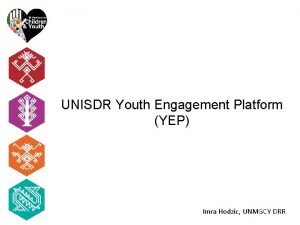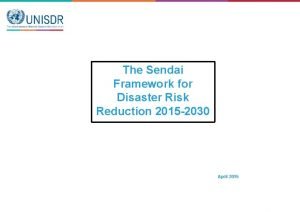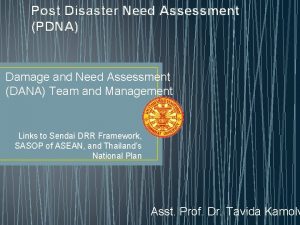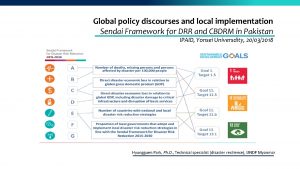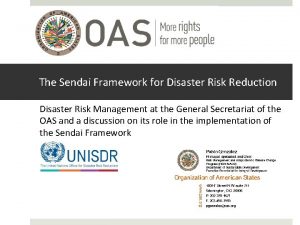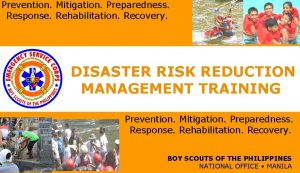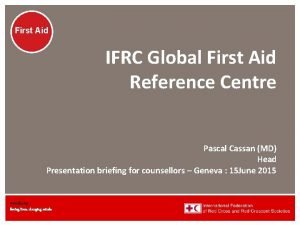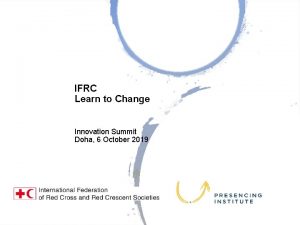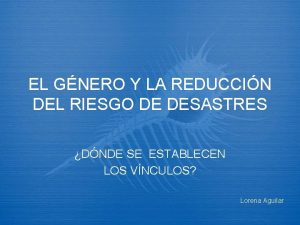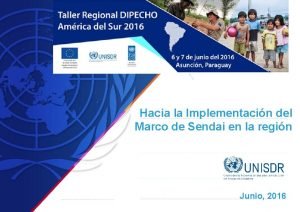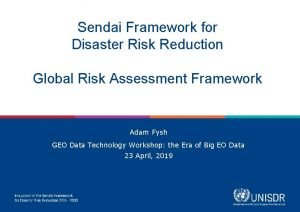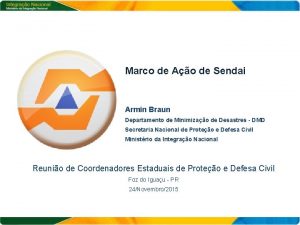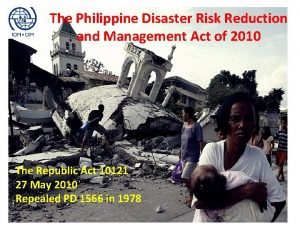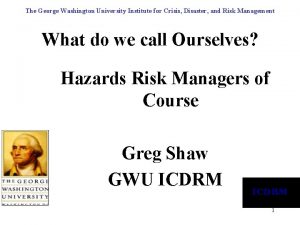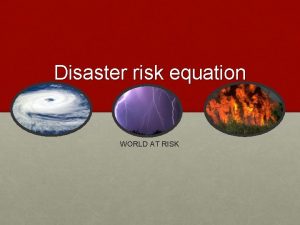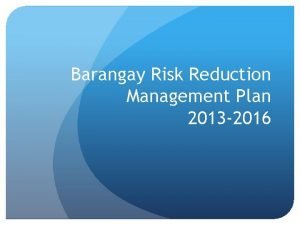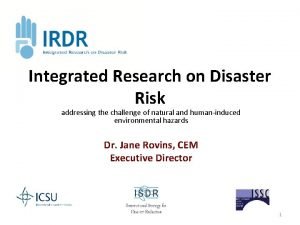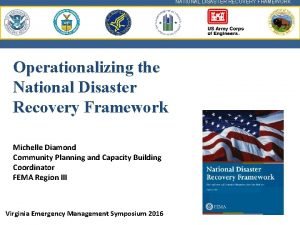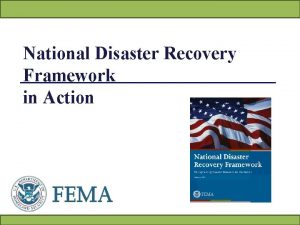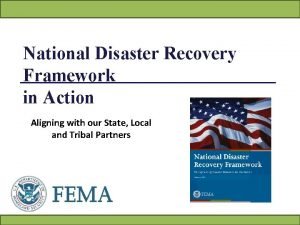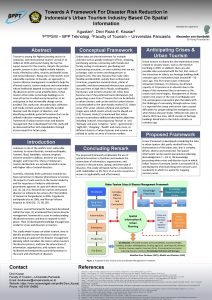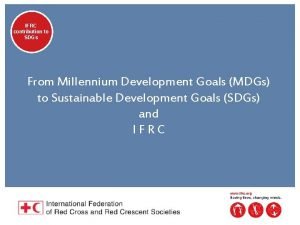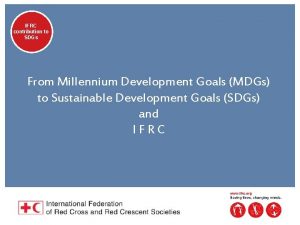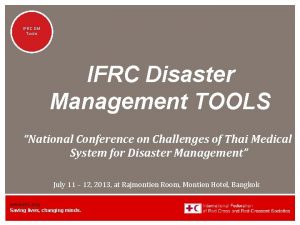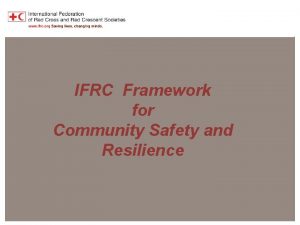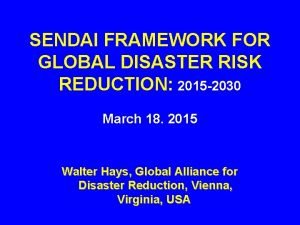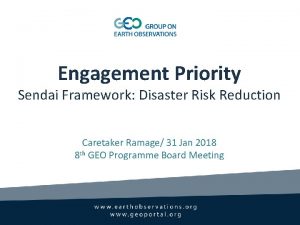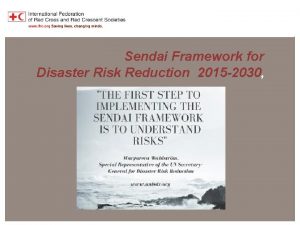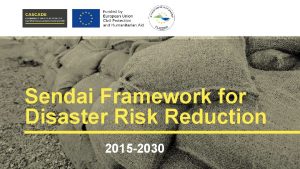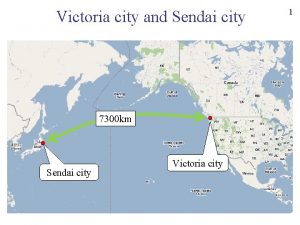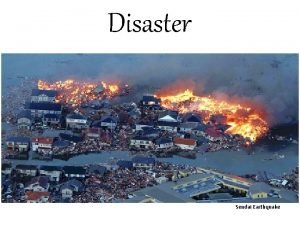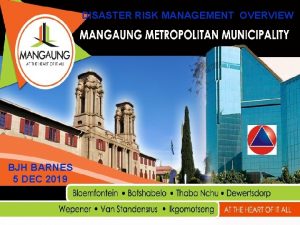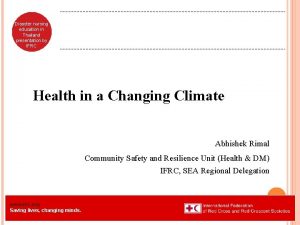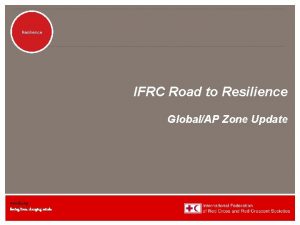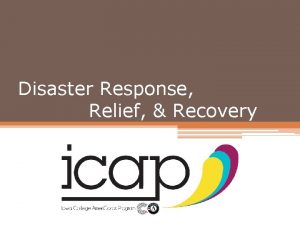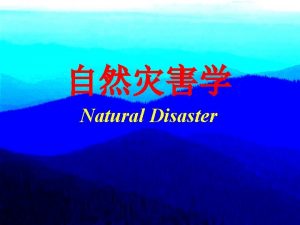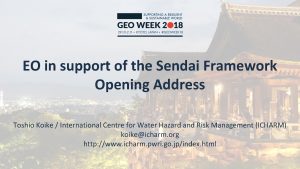SFDRR and IFRC Sendai Framework for Disaster Risk

































- Slides: 33

SFDRR and IFRC Sendai Framework for Disaster Risk Reduction (SFDRR), IFRC contribution and implementation in Asia Pacific From Managing Disasters to Managing Risks Prepared by: Indira Kulenovic, Resilience Coordinator, DMU, Asia Pacific Zone

SFDRR and IFRC

SFDRR and IFRC Expected Outcome “The substantial reduction of disaster risk and losses in lives, livelihoods and health and in the economic, physical, social, cultural and environmental assets of persons, businesses, communities and countries”

SFDRR and IFRC Goal • Focus on preventing new disaster risks, reducing existing disaster risks that also strengthen resilience • Calls for various measures to prevent and reduce hazard exposure and vulnerability, increase preparedness and recovery • Calls for integrated and inclusive economic, structural, legal, social, health, cultural, educational, environmental, technological, political and institutional measures • Calls for increase in preparedness for response and recovery,

SFDRR and IFRC

SFDRR and IFRC Key areas of Sendai Framework for DRR § Focus on Prevention of new risks § Importance of Health § Role of Women and Human rights § Focus on local level and stakeholders § Focus on Stakeholders and inclusive approach § Clear link with financing for development, climate change and the post 2015 -develoment agenda § Focus on recovery, rehabilitation and reconstruction and DRR mainstreaming / Build Back Better

SFDRR and IFRC SFDRR Innovations • Shift from disaster loss to disaster risk • Shift from disaster management to disaster risk management; • Shift from “what to do? ” to “how to do? ” • Focus on people-centered preventive approach to DRR • Primary responsibility of States for DRR • Shared responsibility for DRR with stakeholders • Scope includes slow-onset, man-made and bio hazards; • Set of global targets; • Set of guiding principles;

SFDRR and IFRC SFDRR Innovations • Articulation of governance to manage disaster risk, including role of national platforms; • Understanding, tackling disaster risk drivers; • Preparedness to “build back better”; • Strengthened accountability for disaster risk management; • Recognition of stakeholders and their roles; • Mobilization of risk-sensitive investment; • Global and Regional Plans for coherence, monitoring and periodic reviews; • Resilience of health systems, cultural heritage, and work places;

SFDRR and IFRC

SFDRR and IFRC Role of Stakeholders • • Shift from considering stakeholders as victims and vulnerable to agents of change and focus on empowerment and inclusion Adds indigenous people engagement, and voluntary commitments Specific focus on: • Civil society, volunteers, organized voluntary work & communitybased organizations • Academia, scientific and research entities and networks • Business, professional associations & private sector financial institutions • Media • Parliamentarians

SFDRR and IFRC

SFDRR and IFRC SFDRR - PA 1. Understanding disaster risk. Addressing Policies and Practices for DRR Global and Regional Level National and Local Level Risk mapping, analysis, use/dissemination of obtained information, § awareness raising and education, § access to information through traditional and innovative technologiesand education § integration in policies and strategies § § § Mapping Methodologies and tools for development and dissemination Systems development Campaigns for public awareness and education (i. e. Safe Steps) Access & support for innovative technologies

SFDRR and IFRC Contribution to Priority Area 1. Addressing Policies and practices for DRR National and Local Level § § § § Vulnerability and Capacity Assessment Sectoral assessment GIS / MRA (PMI) RMS Community Resilience programming Public awareness and public education Formal and informal school education Global and Regional Level § § § Rollout of the Framework for Community Resilience Development of tools and guidelines for assessment, PAPE One Billion Coalition for Resilience Road to/from Sendai AMCDRR

SFDRR and IFRC SFDRR - PA 2. Strengthening disaster risk governance to manage disaster risk. Addressing disaster risk governance at all levels § § § § National and Local Level Global and Regional Level Mainstream DRR within and across all sectors Implement DRR strategies and policies Assess DRM capacity Ensure compliance with laws and regulations Strengthen mechanism to monitor implementation of national/local plans Clear roles and responsibilities National and local DRR platforms Empower local authorities § Global and Regional Strategies and mechanisms for KIM and sharing systems § DRR platforms at global/regional levels § Trans boundary cooperation § Monitoring and Assessment of disaster risks / promote exchange of information

SFDRR and IFRC Contribution to Priority Area 2 Addressing disaster risk governance at all levels National and Local Level § § § § Mainstream DRR into RCRC policies and plans NS DRR Frameworks / DRM Strategies Integrated NS development strategies /plans National DRR Platforms Integrated multisectoral community based initiatives/programmes Disaster Laws (DRR&DR) Gender sensitive DRR Beneficiary communication Global and Regional Level § § § § GPDRR IASC AMCDRR & Asia Pacific Road map for implementation of SFDRR RCC GADR 3 ES / APCSS/CFSS ASEAN/SAARC Regional Road Maps (SEA, EA)

SFDRR and IFRC SFDRR - PA 3. Investing in Disaster Risk Reduction for Resilience. Addressing Public & Private investments in DRR to build resilience of individuals, communities, countries Global and Regional Level National and Local Level § § § Governments to allocate resources at all levels for DRR Increase PP investment in disaster resilient structures Promote mainstreaming of DRR into policies land-use, rural development / Building Codes Design/Implementation of inclusive policies integrated with livelihood, health, housing, educations Strengthen the protection of livelihoods and productive assets § § Coherence across organizations related to sustainable development and DRR in policies, plans, programmes and processes Enhance cooperation btwn Health and other stakeholders to improve DRM for Health and other sectors as well Promote / Support Social Safety nets as DRR measures link to livelihoods at household and community levels Strengthen international efforts for hunger and poverty eradication through DRR

SFDRR and IFRC Contribution to Priority Area 3 Addressing Public & Private investments in DRR to build resilience of individuals, communities, countries National and Local Level § § § Allocation of 10% of EA for DP/DRR Promotion of DRR legislation at national and community level Community Resilience Building initiatives /programming (integrated /multi-sectoral i. e: CBDRR, CBHFA, PASSA, PHAST) Partnerships in resilience building Various livelihoods initiatives (cash distribution, IG projects, etc) Global and Regional Level One Billion Coalition for Resilience § Call for Innovation / Beijing Declaration § Regional Voluntary Commitments § AP Resilience Road map §

SFDRR - PA 4. Enhancing disaster preparedness for effective response, and to “Build Back Better” in recovery, rehabilitation and reconstruction SFDRR and IFRC Addressing strengthening of disaster preparedness for response, integration of DRR in response preparedness and capacity building National and Local Level § § § § Contingency policies/plans/programs People centered Multi-hazard, multisectoral EWS Emergency stock-piling Post-emergency planning Capacity building in disaster preparedness and response Simulation exercises Mainstreaming DRR into recovery and longer-term development § § § Collaboration between all stakeholders Evacuation Dead Body Management PSP Support Disaster response Laws

IFRC Contribution to Priority Area 4 at National and Local levels SFDRR and IFRC Addressing strengthening of disaster preparedness for response, integration of DRR in response preparedness and capacity building § § § National Disaster Preparedness and response mechanism (NDPRM) which include the below points: National Society Contingency plans HCT/Cluster Coordination, Pre-disaster meetings People centered Multi-hazard, multi-sectoral EWS Emergency stock-piling/buffer stocks Post-emergency planning Capacity building in disaster preparedness and response (National Disaster Response Teams –NDRT, BDRTs) Simulation exercises/Mock drills Mainstreaming DRR into recovery & Build Back Better approach Mainstreaming Gender and diversities into all programming tools and implementation Promote IDRL

SFDRR – PA. 4. Enhancing disaster preparedness for effective response, and to “Build Back Better” in recovery, rehabilitation and reconstruction SFDRR and IFRC Addressing strengthening of disaster preparedness for response, integration of DRR in response preparedness and capacity building Global and Regional Levels § § § Regional response mechanisms Standards, Codes, Guidelines Regional multi-hazard EWM Awareness raising on hydrological issues and impact on society Regional cooperation in Disaster Preparedness including simulation exercises Sharing response and resources during and after disasters

IFRC Contribution to Priority Area 4 at Global and Regional Levels SFDRR and IFRC Addressing strengthening of disaster preparedness for response, integration of DRR in response preparedness and capacity building § § § § § Principles and Rules for Humanitarian Assistance Asia Pacific Standard Operating Procedures Global and regional response tools (FACT, ERU, RDRT, DREF) Support National Disaster Preparedness and Response Mechanisms (NDPRM) Regional Logistics Centers DRR mainstreaming in Emergency and Recovery Appeals Participation in Di. REX, ARDEX, IASC Disaster Law (i. e. ASEAN/SAARC) including studies

SFDRR and IFRC

SFDRR and IFRC

SFDRR and IFRC By States • Appoint national focal points • Nominate experts to open-ended inter-governmental working group for development of indicators & terminology • Update: risk information for biological, man-made hazards, national & local & regional DRR strategies & plans, • Report status of implementation of plans • Identify baselines & set targets for risks and DRR action • Review and update relevant national legislation • Promote local platforms on DRR and coherence across agreements

SFDRR and IFRC By Stakeholders • • Support development of guide to implementation Implement over 200 commitments made Integrate SFDRR in their work Support States in implementation Support inter-governmental process to update DRR terminology & plan to support implementation Promote coherence across conferences Prepare for the 2017 Global Platform & regional platforms

SFDRR and IFRC By UNISDR • • Implement activities as mandated in Sendai Framework Participate in work of Inter-Agency and Expert Group on Sustainable Development Indicators Lead revision of the United Nations Plan of Action on Disaster Risk Reduction for Resilience Update the HFA monitor Maintain inventory of commitments Prepare next cycle of regional and Global Platforms Define five-year strategy and two-year work plan

SFDRR and IFRC IMPLEMENTATION OF THE SFDRR IN ASIA – FROM SENDAI TO DELHI REGIONAL PLATFORM LED BY UN ISDR

National & Local National & local DRR strategies & plans Baseline, Targets Update risk information Sub-regional/IGOs ADDMER Work Programme Regional Implementation Plan of SFDRR SAARC roadmaps Other frameworks Ten Stakeholder Groups Voluntary Commitments; UN Plan of Action National & Local Platforms Sub-regional Platforms/IGO Governance meetings AMCDRR 2016 in India 2018 in … 2020 in …. Progress reviewed nationally and at sub-regional and regional platforms

Ten stakeholders groups in Asia Parliamentarians National Societies of Red Cross and red Crescent IFRC Group on Gender Equality and Women’s Empowerment in Disaster Risk Management and Regional Resilience Building Media Science, Technology and Academia Private Sector Children, Youth and Child Centered Organizations Mayors and Local Government Authorities Asian Civil Society Organizations Individuals and organizations concerned with disability

• The objectives of regional platform is to: • Provide policy framework for SFDRR implementation in Asia and the Regional Road Map for Implementation • Provide policy guidelines for governments and stakeholders • Serve as reference for monitoring the SFDRR progress

Building on HFA regional strategies through AMCDRR Beijing 2005 Delhi 2007 Highlighted the relevance of DRR for poverty reduction and sustainable development in Asia. Called for National Plans for Action and strengthening of existing regional collaboration mechanisms Agreed on biennial Ministerial Conference as a multi-stakeholder Regional Platform for DRR. Called for the enhancement of partnership in DRR. Affirmed UNISDR role to provide secretarial support to Regional Platform Incheon 2010 Yogyakarta, 2012 Regional Roadmap on DRR through CCA (REMAP): to make DRR and CCA priorities in national policies and build synergies between them at the national, regional, and global levels Called for capacity building for local risk assessment, mainstreaming local DRR into national development, financing DRR. Inputs for the post-2015 framework for DRR. Ten Stakeholder Groups statements of commitments Kuala Lumpur 2008 Emphasized multi-stakeholder partnerships and private sector role. Recognized the role of local authorities. Called for capacity building of local authorities and communities Bangkok, 2014 Called to strengthen local resilience, investments in disaster and climate risk management and PPP. Adopted Asia-Pacific Inputs for the post-2015 framework for DRR. Agreed to prepare Regional Implementation Plan. Stakeholders commitments

Timeline 2015 2016 IAP, Feb (TBC) IAP, June Roadmap, initial outline of AMCDRR, identified contributions UNGA Sept Adopt WCDRR outcomes Country DRM status evaluations, National Implementation Plans 1 st draft Regional Road Map for Implementation IAP, August (TBC) Final Draft Regional Road Map for Implementation IAP, Nov + Ministerial Dialogue (TBC) December Define SFDRR periodic review First Country DRM status evaluations, National/Local Implementation Plans Initial draft Policy Dialogue and Sector Briefs 1 st AMCDRR, New Delhi, Nov 2016 Adopt Regional Road Map for Implementation

SFDRR and IFRC Thank
 Yep 10
Yep 10 Priority of sendai framework
Priority of sendai framework Priority of sendai framework
Priority of sendai framework Priority of sendai framework
Priority of sendai framework Sendai framework philippines
Sendai framework philippines Gender based violence
Gender based violence National disaster risk reduction and management framework
National disaster risk reduction and management framework Perbedaan icrc dan ifrc
Perbedaan icrc dan ifrc Global first aid reference centre
Global first aid reference centre Learn to change ifrc
Learn to change ifrc Market risk credit risk operational risk
Market risk credit risk operational risk Mediateca de sendai
Mediateca de sendai Diferencia entre el marco de hyogo y sendai
Diferencia entre el marco de hyogo y sendai Hyogo çerçeve eylem planı başlığı
Hyogo çerçeve eylem planı başlığı Marco de sendai 7 metas
Marco de sendai 7 metas Global risk assessment framework
Global risk assessment framework Marco de sendai
Marco de sendai In the new drm law, ndcc became
In the new drm law, ndcc became Institute for crisis disaster and risk management
Institute for crisis disaster and risk management Complete the equation: (+hazard) / capacity=disaster *
Complete the equation: (+hazard) / capacity=disaster * Barangay disaster risk reduction management plan
Barangay disaster risk reduction management plan Integrated research on disaster risk
Integrated research on disaster risk National disaster recovery framework 2016
National disaster recovery framework 2016 National disaster recovery framework
National disaster recovery framework National disaster recovery framework
National disaster recovery framework Towards a framework for tourism disaster management
Towards a framework for tourism disaster management Residual risk and secondary risk pmp
Residual risk and secondary risk pmp Business vs financial risk
Business vs financial risk Attributable risk
Attributable risk Attributable risk formula
Attributable risk formula Theoretical and conceptual framework example
Theoretical and conceptual framework example Fspos vägledning för kontinuitetshantering
Fspos vägledning för kontinuitetshantering Typiska drag för en novell
Typiska drag för en novell Nationell inriktning för artificiell intelligens
Nationell inriktning för artificiell intelligens
